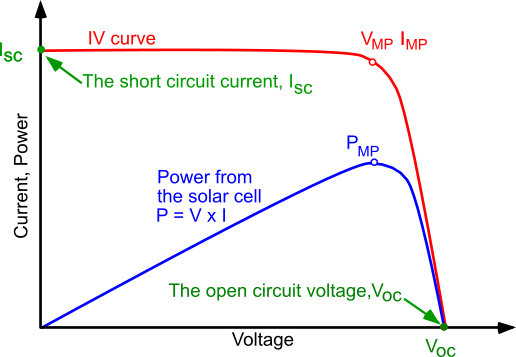The IV curve of a solar cell is the superposition of the IV curve of the solar cell diode in the dark with the light-generated current.1 The light has the effect of shifting the IV curve down into the fourth quadrant where power can be extracted from the diode. Illuminating a cell adds to the normal "dark" currents in the diode so that the diode law becomes:
$$I=I_{0}\left[\exp \left(\frac{q V}{n k T}\right)-1\right]-I_{L}$$
where IL = light generated current.
 The ideal short circuit flow of electrons and holes at a p-n junction. Minority carriers cannot cross a semiconductor-metal boundary and to prevent recombination they must be collected by the junction if they are to contribute to current flow.
The ideal short circuit flow of electrons and holes at a p-n junction. Minority carriers cannot cross a semiconductor-metal boundary and to prevent recombination they must be collected by the junction if they are to contribute to current flow.
The effect of light on the current-voltage characteristics of a p-junction.
The equation for the IV curve in the first quadrant is:
Ideal Solar Cell
The -1 term in the above equation can usually be neglected. The exponential term is usually >> 1 except for voltages below 100 mV. Further, at low voltages, the light generated current IL dominates the I0 (...) term so the -1 term is not needed under illumination.
Ideal Solar Cell (simplified)
Plotting the above equation gives the IV curve below with the relevant points on the curve labeled and discussed in more detail on the following pages. The power curve has a a maximum denoted as PMP where the solar cell should be operated to give the maximum power output. It is also denoted as PMAX or maximum power point (MPP) and occurs at a voltage of VMP and a current of IMP.

Several important parameters which are used to characterize solar cells are discussed in the following pages. The short-circuit current (ISC), the open-circuit voltage (VOC), the fill factor (FF) and the efficiency are all parameters determined from the IV curve.
Rearranging the equation above gives the voltage in terms of current:
$$ V = \frac{n k T}{q} ln \left(\frac{I_L – I}{I_0}\right) $$
When I > IL the number in side the ln( ) is negative and undefined. So what happens in reality? The solar cell goes into reverse bias (negative voltage) and either the non-idealities in the solar cell limit the voltage or the supply limits the voltage. In either case, the solar cell will dissipate power. If there is no limit on the supply then a solar cell close to ideal (very high RSHUNT in reverse bias) will be destroyed almost instantly. Other cells will be destroyed due to heating. The problem of power dissipation in solar cells in reverse bias is covered in the module chapter and in particular the use of bypass diodes.
- 1. , «Application of the superposition principle to solar-cell analysis», IEEE Transactions on Electron Devices, vol. 26, pp. 165–171, 1979.
